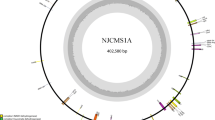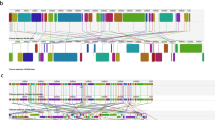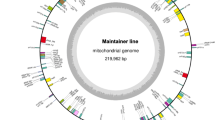Abstract
WA-CMS system based rice hybrids are widely adopted in many rice growing countries, including India. Even though it is well known that the trait is controlled by mitochondria, the genes underpinning the trait remain enigmatic. In the present study, a complete genome-wide comparative sequence analysis was performed using draft mitochondrial genomes of WA-CMS and male fertile lines in a step-wise manner, progressively covering 5–10 kb every time through BLASTN tool. The sequence polymorphisms identified in different mitochondrial regions were targeted to develop two different sets of dominant PCR-based markers, one consisting of six markers targeting WA-CMS mitochondria, the other set consisting of five markers targeting male fertile mitochondria in addition to development of a set of eight co-dominant PCR-based markers targeting both the genomes. When a set of candidate genes/ORFs reported earlier to be associated with WA-CMS trait in rice were analyzed through RT-PCR of RNA isolated from immature rice florets, it was observed that the chimeric ORF, WA352 is expressed only in WA-CMS line and hybrid (i.e. genotypes containing sterile mitochondria), indicating it’s candidacy for the WA-CMS trait. Targeting the functional nucleotide polymorphism between WA-CMS and maintainer mitochondria with respect to WA352, two dominant markers, one targeting sterile and another targeting fertile mitochondria were developed. In addition, a robust, co-dominant functional marker targeting the candidate gene was also developed and validated for its utility in identification of genetic impurities in seed lots of WA-CMS lines.


Similar content being viewed by others
References
Altschul SF, Gish W, Miller W, Myers EW, Lipman DJ (1990) Basic local alignment search tool. J Mol Biol 215:403–410
Balaji S, Vemireddy LR, Srikanth B, Dharika N, Sambasiva Rao KRS, Hemanth Kishore V, Sundaram RM, Viraktamath BC, Subhakara Rao I, Ramesha MS, Neeraja CN (2012) Fine mapping of Rf3 and Rf4 fertility restorer loci of WA-CMS of rice (Oryza sativa L.) and validation of the developed marker system for identification of restorer lines. Euphytica 187:421–435
Bentolila S, Stefanov S (2012) A reevaluation of rice mitochondrial evolution based on the complete sequence of male-fertile and male-sterile mitochondrial genomes. Plant Physiol 158:996–1017
Cai CL, Yang Z, Zhu YG (1998) Analysis of rice mitochondrial DNA of sporophyte male sterility lines by RAPD. Yi Chuan Xue Bao 25:525–530
Das S, Sen S, Chakrabort A, Chakraborti P, Maiti MK, Basu A, Basu D, Sen KS (2010) An unedited 1.1 kb mitochondrial orfB gene transcript in the wild abortive cytoplasmic male sterility (WA-CMS) system of Oryza sativa L. subsp. Indica. BMC Plant Biol 10:39
Fujii S, Kazama T, Yamada M, Toriyamaws K (2010) Discovery of global genomic re-organization based on comparison of two newly sequenced rice mitochondrial genomes with cytoplasmic male sterility-related genes. BMC Genom 11:209
Hall T (2007) BioEdit version 7.0.9. Carlsbad, CA: Computer Program and documentation, Ibis Biosciences. http://www.mbio.ncsu.edu/BioEdit/bioedit.html
Higgins D, Thompson J, Gibson Thompson JD, Higgins DG, Gibson TJ (1994) CLUSTALW: improving the sensitivity of progressive multiple sequence alignment through sequence weighting, position-specific gap penalties and weight matrix choice. Nucleic Acids Res 22:4673–4680
Igarashi K, Kazama T, Motomura K, Toriyama K (2013) Whole genomic sequencing of RT98 mitochondria derived from Oryza rufipogon and northern blot analysis to uncover a cytoplasmic male sterility-associated gene. Plant Cell Physiol 54:237–243
Kochert G, Tanksley SD, Price JP (1989) RFLP training course laboratory manual. Rockefeller Program on Rice Biotechnology. Cornell University, Ithaca, pp 5–6
Laser KD, Lersten NR (1972) Anatomy and cytology of microsporogenesis in cytoplasmic male sterile angiosperms. Bot Rev 38:425–454
Li JM, Yuan LP (2000) Hybrid rice, genetics, breeding, and seed production. In: Janick J (ed) Plant breeding reviews, vol 17. Wiley, New York, pp 15–158
Lin SC, Yuan LP (1980) Hybrid rice breeding in China. Innovative approaches to rice breeding. International Rice Research Institute, Manila, pp 35–51
Liu ZL, Xu H, Guo JX, Liu YG (2007) Structural and expressional variations of the mitochondrial genome conferring the wild abortive type of cytoplasmic male sterility in rice. J Integr Plant Biol 49:908–914
Luo DP, Xu H, Liu ZL, Guo JX, Li HY, Chen LT, Fang C, Zhang QY, Bai M, Yao N, Wu H, Wu H, Ji CH, Zheng HQ, Chen YL, Ye S, Li XY, Zhao XC, Li RQ, Liu YG (2013) A detrimental mitochondrial-nuclear interaction causes cytoplasmic male sterility in rice. Nat Genet 45:573–577
Mulligan RM, Dement E, Andre C, Walbot V (1988) Isolation of RNA and DNA from rice seedling mitochondria. Rice Genet. Newsl. 5:151–154
Okazaki M, Kazama T, Murata H, Motomura K, Toriyama K (2013) Whole mitochondrial genome sequencing and transcriptional analysis to uncover an RT 102-type cytoplasmic male sterility-associated candidate gene derived from Oryza rufipogon. Plant Cell Physiol 54(9):1560–1568
Pranathi K, Viraktamath BC, Hajira S, Balachiranjeevi CH, Koteshwar Rao P, Bhaskar S, Abhilashkumar V, Rekha G, Anila M, Mahadevaswamy HK, Harika G, Swapnilkulkarni BVN, Kousik M, Balachandran SM, Madhav MS, Neeraja CN, Hari Prasad AS, Sundaram RM (2014) Analysis of WA-CMS and maintainer lines using mitochondrial genome specific molecular markers. Progress Res (Conf Spl) 9:1159–1163
Rajendrakumar P, Biswal AK, Balachandran SM, Ramesha MS, Viraktamath BC, Sundaram RM (2007) A mitochondrial repeat specific marker for distinguishing wild abortive type cytoplasmic male sterile rice lines from their cognate isogenic maintainer lines. Crop Sci 47:207–211
Rajendran N, Ramkumar G, Singh Sukhpal, Kadirvel P (2007) Development of a DNA marker for distinguishing CMS lines from fertile lines in rice (Oryza sativa L.). Euphytica 156:129–139
Rao YS (1988) Cyto histology of cytoplasmic male sterile lines in hybrid rice. In: Smith WH, Bostian LR, Cervantes EP (eds) Hybrid rice. International Rice Research Institute, Manila, pp 115–128
Schnable PS, Wise RP (1998) The molecular basis of cytoplasmic male sterility and fertility restoration. Trends Plant Sci 3:175–180
Shaoqing L, Daichang Y, Yingguo Z (2007) Characterization and use of male sterility in hybrid rice breeding. J Integr Plant Biol 49:791–804
Shinjyo C (1969) Cytoplasmic genetic male sterility in cultivated rice, Oryza sativa L. II. The inheritance of male sterility. Jpn J Genet 44:149–156
Shuangping H, Chao W, Bing J, Zhengjie W, Jing W, Bin Y, Chaozhi M, Jinxing T, Tingdong F, Jinxiong S (2014) Comparative analysis of mitochondrial genomes between the hau cytoplasmic male sterility (CMS) line and its iso-nuclear maintainer line in Brassica juncea to reveal the origin of the CMS-associated gene orf288. BMC Genom 15:322
Singh N, Jayaswal PK, Panda K, Mandal P, Kumar V, Singh B, Mishra S, Singh Y, Singh R, Rai V, Gupta A, Sharma TR, Singh NK (2015) Single-copy gene based 50 K SNP chip for genetic studies and molecular breeding in rice. Sci Rep 5:11600. doi:10.1038/srep11600 (published online)
Sinha P, Saxena KB, Rachit KS, Vikas KS, Suryanarayana V, Sameer Kumar CV, Katta Mohan AVS, Aamir WK, Rajeev KV (2015) Association of nad7a gene with cytoplasmic male sterility in pigeonpea. Plant Genome 8(2):1–12
Suzuki H, Yu J, Wang F, Zhang J (2013) Identification of mitochondrial DNA sequence variation and development of single nucleotide polymorphic markers for CMS-D8 in cotton. Theor Appl Genet 126:1521–1529
Tanaka Y, Tsuda M, Yasumoto K, Yamagishi H, Terachi T (2012) A complete mitochondrial genome sequence of Ogura-type male-sterile cytoplasm and its comparative analysis with that of normal cytoplasm in radish (Raphanus sativus L.). BMC Genom 13:352
Tuteja R, Saxena RK, Davila J, Shah T, Chen W, Xiao YL, Fan G, Saxena KB, Alverson AJ, Spilliane C, Town C, Varshney RK (2013) Cytoplasmic male sterility-associated chimeric open reading frames identified by mitochondrial genome sequencing of four Cajanus genotypes. DNA Res 20:485–495
Virmani SS (1996) Hybrid rice. Adv Agron 57:377–462
Xie H, Wang J, Qian M, Li N, Zhu Y, Li S (2014) Mitotype-specific sequences related to cytoplasmic male sterility in Oryza species. Mol Breeding 33:803–811
Yan W (2000) Crop heterosis and herbicide. US Patent No. 6,066,779
Yashitola J, Thirumurugan T, Sundaram RM, Naseerullah MK, Ramesha MS, Sarma NP, Sonti RV (2002) Assessment of purity of rice hybrids using microsatellite and STS markers. Crop Sci 42:1369–1373
Yashitola J, Sundaram RM, Biradar SK, Thirumurugan T, Vishnupriya MR, Rajeshwari R, Viraktamath BC, Sarma NP, Sonti RV (2004) A sequence specific PCR marker for distinguishing rice lines on the basis of wild abortive cytoplasm from their cognate maintainer lines. Crop Sci 44:920–924
Acknowledgments
Pranathi K would like to thank Department of Science and Technology (DST), Government of India for the INSPIRE fellowship awarded for Ph.D. studies. The authors would also like to thank the Indian Council of Agricultural Research and Department of Biotechnology, Government of India for the generous funding support for the research work presented in the study and acknowledge the kind support and encouragement received from Dr. V. Ravindra Babu, Director, ICAR-IIRR, Hyderabad, India.
Author information
Authors and Affiliations
Corresponding author
Additional information
K. Pranathi and R. M. Sundaram have contributed equally to this study.
Electronic supplementary material
Below is the link to the electronic supplementary material.
Rights and permissions
About this article
Cite this article
Pranathi, K., Viraktamath, B.C., Neeraja, C.N. et al. Comparative analysis of sequences of mitochondrial genomes of wild abortive male sterile (WA-CMS) and male fertile lines of rice, development of functional markers for WA-CMS trait and their use in assessment of genetic purity of seeds of WA-CMS lines. Mol Breeding 36, 21 (2016). https://doi.org/10.1007/s11032-016-0445-3
Received:
Accepted:
Published:
DOI: https://doi.org/10.1007/s11032-016-0445-3




